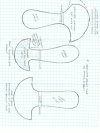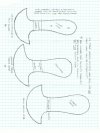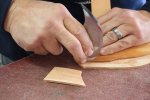- Joined
- Oct 16, 2010
- Messages
- 5,581
Greetings All:
Recently I've decided to buy myself a round knife for leather working. I did some Google searches and found quite a few different threads on round knifes - seems everyone has their opinion on what constitutes a good one. Some swear by the old ones that go for a king's ransom, some swear by the $300 models that are made in the US, France, Germany, etc. Then there is the topic of steels to use. The more I looked into it, I found out how less I knew about the design, the size, shape, the thickness, and what worked well.
When I get contacted by a client who asks for my recommendations based on my years of hunting experience, I make recommendations and end up with a happy client who gets the knife for the type of game he's hunting. I don't usually offer advice unless it's asked for because this old war horse has found out that "Advice is something fools won't use and wise men don't need." Less drama this way too - I get all the drama I need by watching the news.
That said, I decided to get Paul Long's advice on round knife construction. We agreed that a thread, building a round knife to Paul's specifications, would be a benefit to you knife makers out there that do your own leather work. Why pay $300 for a good round knife when you guys can make one for yourselves? Paul will be chiming in on this thread, particularly on the design elements that he feels works best when cutting leather. I have chosen AEB-L as the steel - it holds an edge nicely, is easy to sharpen and is fine grained. Paul likes it too - he has a skyving knife made out of AEB-L that he likes and fully supports the choice. One advantage is that AEB-L can be bought in the thickness that Paul likes best for his knives. There are other good steels out there too - rather than debate that aspect here, feel free to choose YOUR favorite steel to make YOUR head knife.
Paul provided me tracings of his favorite round knives - I am attaching them to this thread for you fellas to copy and use as profile templates. Here you go - the profiles are on 1/4" square graph paper.
Paul - please provide your comments on design and the configuration of the round knife we agreed to build. Also, your views on the difference between a round knife and a head knife would be appreciated.
V/R,
TK


Recently I've decided to buy myself a round knife for leather working. I did some Google searches and found quite a few different threads on round knifes - seems everyone has their opinion on what constitutes a good one. Some swear by the old ones that go for a king's ransom, some swear by the $300 models that are made in the US, France, Germany, etc. Then there is the topic of steels to use. The more I looked into it, I found out how less I knew about the design, the size, shape, the thickness, and what worked well.
When I get contacted by a client who asks for my recommendations based on my years of hunting experience, I make recommendations and end up with a happy client who gets the knife for the type of game he's hunting. I don't usually offer advice unless it's asked for because this old war horse has found out that "Advice is something fools won't use and wise men don't need." Less drama this way too - I get all the drama I need by watching the news.
That said, I decided to get Paul Long's advice on round knife construction. We agreed that a thread, building a round knife to Paul's specifications, would be a benefit to you knife makers out there that do your own leather work. Why pay $300 for a good round knife when you guys can make one for yourselves? Paul will be chiming in on this thread, particularly on the design elements that he feels works best when cutting leather. I have chosen AEB-L as the steel - it holds an edge nicely, is easy to sharpen and is fine grained. Paul likes it too - he has a skyving knife made out of AEB-L that he likes and fully supports the choice. One advantage is that AEB-L can be bought in the thickness that Paul likes best for his knives. There are other good steels out there too - rather than debate that aspect here, feel free to choose YOUR favorite steel to make YOUR head knife.
Paul provided me tracings of his favorite round knives - I am attaching them to this thread for you fellas to copy and use as profile templates. Here you go - the profiles are on 1/4" square graph paper.
Paul - please provide your comments on design and the configuration of the round knife we agreed to build. Also, your views on the difference between a round knife and a head knife would be appreciated.
V/R,
TK


Last edited:




